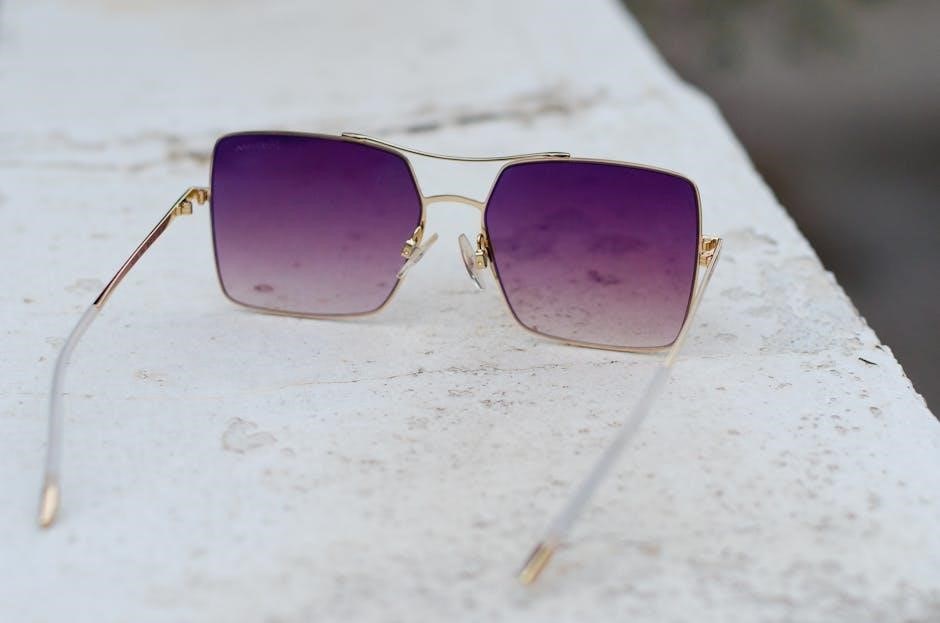sunglasses frame size guide

Choosing the right sunglasses frame size ensures both comfort and style. This guide helps you understand measurements, face shapes, and how to select frames that fit perfectly and enhance your features while providing optimal protection.
1.1 Importance of Proper Frame Size
Proper frame size ensures sunglasses fit comfortably and function effectively. Ill-fitting frames can slip down, cause discomfort, or fail to provide adequate UV protection. Correct sizing guarantees optimal coverage, reducing light leakage around the edges. Frames that are too tight may cause pressure, while overly large frames can look unflattering. A well-fitting frame enhances both style and functionality, ensuring clear vision and protection. Understanding your face shape and measurements is key to selecting frames that complement your features and meet your needs, making proper fit essential for both practicality and personal style.
1.2 Understanding Frame Measurements
Frame measurements are crucial for ensuring a proper fit. They typically consist of three key components: lens width, bridge width, and temple length. Lens width is the horizontal measurement of the lens, bridge width is the distance between the two lenses, and temple length measures the arms that hold the frames in place. These measurements are usually provided in millimeters and are essential for selecting frames that suit your face size and shape. Accurate measurements ensure comfort and optimal coverage, making them vital for choosing the right sunglasses. Understanding these dimensions helps in making informed decisions when purchasing frames online or in-store.

Key Components of Sunglasses Frame Measurements
The key components of sunglasses frame measurements include lens width, bridge width, and temple length, each playing a crucial role in ensuring a proper fit and comfort.
2.1 Lens Width: The First Measurement
Lens width is the first measurement in sunglasses frames, representing the widest part of the lens. It ensures the frames proportionally match your face width, providing optimal coverage and style. Proper lens width aligns with your face’s widest points, avoiding frames too narrow or wide. Measured in millimeters, it’s crucial for comfort and visual balance, ensuring your sunglasses complement your features without compromising protection or aesthetics. Always measure this accurately for a perfect fit and to enhance your overall look.
2.2 Bridge Width: The Second Measurement
Bridge width is the second measurement in sunglasses frames, representing the distance between the two lenses. It sits on the nose and plays a crucial role in comfort and fit. A proper bridge width ensures the frames rest securely without pressing too hard or slipping down. Measured in millimeters, it varies to suit different nose sizes and face shapes. Wider bridges are ideal for larger noses, while narrower ones are better for smaller faces. Choosing the right bridge width ensures a balanced look and prevents discomfort, making it essential for both functionality and style.
2.3 Temple Length: The Third Measurement
Temple length is the third measurement, indicating the distance from the hinge to the end of the arm. It ensures the sunglasses stay securely in place. Measured in millimeters, temple length is crucial for comfort and stability. Longer temples provide a firmer grip, while shorter ones suit smaller heads or those with thicker hair. Proper temple length prevents slipping and ensures the frames sit evenly on both sides of the face. It’s essential for a balanced fit, especially for active individuals or those with specific head shapes. Accurate measurement ensures the temples don’t cause discomfort or slide down, offering both functionality and style.

How to Measure Your Face for Sunglasses
Measuring your face involves determining its width and height to ensure proper fit. Use a ruler or cloth tape to measure horizontally across your temples and vertically from forehead to chin for accurate sizing;
3.1 Measuring Face Width
Face width is measured horizontally across the widest part of your face, typically from temple to temple. Use a millimeter ruler or cloth tape to ensure accuracy. Stand straight and look ahead, aligning the measuring tool with the outer corners of your eyes. Record this width to determine the ideal frame size, ensuring the sunglasses fit comfortably without extending beyond your temples or appearing too narrow. This measurement is crucial for proportionate frames that complement your facial structure and provide optimal coverage. Proper alignment ensures accuracy and a precise fit.
3.2 Measuring Face Height
Face height is measured vertically from the middle of your forehead to the bottom of your chin. Use a millimeter ruler or cloth tape for accuracy. Stand straight, look ahead, and align the tool vertically. This measurement helps determine the proportion of your sunglasses frames, especially the height of the lenses. For elongated faces, taller frames can balance the proportions, while shorter frames suit rounder faces. Ensure the ruler is straight and the measurement is taken smoothly to get an accurate reading. This step is essential for selecting frames that complement your facial structure and ensure a balanced look. Proper measurement ensures the best fit.
3.3 Measuring Temple Length
Temple length refers to the distance from the temple tip to the end of the earpiece. Use a millimeter ruler or cloth tape to measure this accurately. Place the ruler horizontally behind your ear, aligning it with the temple tip, and extend it to the end of the earpiece. Proper temple length ensures comfort and prevents slipping. For smaller faces, shorter temples (135-140mm) are ideal, while larger faces may require longer temples (145-150mm). Measure both sides to ensure symmetry. Accurate temple length ensures a secure, comfortable fit, preventing the sunglasses from slipping down your nose or feeling too tight. Proper measurement is key for optimal wearability.

Determining Your Sunglasses Size Based on Face Shape
Understanding your face shape helps select frames that complement your features. Round faces suit angular frames, while square faces benefit from softer shapes. Oval faces are versatile, but narrower frames work best. Heart-shaped faces look great with wider bottom frames, and triangular faces balance with broader top frames. This section provides tailored recommendations for each face type to ensure a flattering fit and enhanced appearance.
4.1 Round Faces: Frame Recommendations
Round faces benefit from frames that add definition and contrast soft features. Angular or geometric shapes, such as square or rectangular frames, work well to elongate the face. Avoid overly round or curved frames, as they may emphasize roundness. Opt for frames with longer temples to balance the proportions. The frame width should be proportional to the face width, ideally extending slightly beyond the temples for a slimming effect. Bold or oversized frames can also create a striking look while maintaining balance. Consider frames with contrasting details to draw attention upward or outward, enhancing facial symmetry and creating a more defined appearance.
4.2 Square Faces: Frame Recommendations
Square faces are characterized by strong, angular features and a broad jawline. To soften these sharp angles, opt for rounded or curved frame shapes, such as aviator, round, or soft cat-eye styles. These frames add contrast and balance the definition of square faces. Avoid overly angular or boxy frames, as they may accentuate the squareness. Frames with a wider lens width relative to the face width can also create a more balanced look. Ensure the frames sit proportionally on the face, neither too narrow nor too wide, to avoid overwhelming the features. Rounded frames will help create a softer, more harmonious appearance while maintaining a stylish edge.
4.3 Oval Faces: Frame Recommendations
Oval faces are considered ideal for a wide variety of frame styles due to their balanced proportions. The face is slightly longer than it is wide, with soft, curved features. For oval faces, frames that are as wide as or slightly wider than the broadest part of the face work best. Rectangular, square, or geometric frames can add structure, while round or aviator styles enhance the natural symmetry. Avoid frames that are overly large or too small, as they may unbalance the face. Medium to large-sized frames in proportion to the face width are recommended for a flattering look that complements the oval shape.
4.4 Heart-Shaped Faces: Frame Recommendations
Heart-shaped faces are characterized by a broad forehead and temples, with a narrower chin. To balance this, frames should draw attention downward and create width at the lower part of the face. Round or aviator styles are ideal, as they soften angular features and add width to the chin area. Frames with a wider bottom than top or those with decorative temple tips can also help balance the proportions. Avoid overly tall or narrow frames, as they may accentuate the width of the upper face. Medium-sized frames with a subtle design work best for heart-shaped faces, ensuring a harmonious and flattering look.
4.5 Triangular Faces: Frame Recommendations
Triangular faces are defined by a narrow top and wider bottom. To balance this, frames should add width to the upper part of the face while minimizing the width at the bottom. Cat-eye or semi-rimless styles are ideal, as they draw attention upward and create a broader appearance at the temples. Frames with colorful or decorative accents on the upper section can also help balance the proportions. Avoid overly narrow or V-shaped frames, as they may emphasize the narrowness of the top. Instead, opt for designs that add volume to the upper face, ensuring a balanced and harmonious look overall.

Choosing Proportional Frames
Choosing proportional frames ensures a balanced look. Consider face width and height when selecting. Opt for frames that match your features without extending beyond temples or appearing too narrow.
5.1 Frame Width in Relation to Face Width
Frame width should align with your face width for a balanced look. Measure your face across the temples to determine the ideal frame size. For smaller faces, narrower frames (less than 129mm) are best, while wider faces suit frames over 139mm. Medium faces (130-139mm) offer versatility. Ensure frames don’t extend beyond your temples or appear too narrow. Proportional frames enhance comfort and aesthetics, balancing facial features. Use a millimeter ruler or cloth tape to measure accurately. Proper fit ensures sunglasses stay in place and provide optimal protection without slipping or discomfort.
5.2 Frame Height in Relation to Face Height
Frame height should complement your face height for a balanced appearance. Measure your face vertically from the eyebrow to the jawline. Taller frames (over 50mm) suit elongated faces, while shorter frames (under 45mm) are ideal for rounder faces. Medium heights (45-50mm) work well for average face proportions. Ensure frames don’t overwhelm or get lost on your face. Proper height ensures a natural fit, enhancing both style and functionality. Use a ruler or measuring tape to assess your face height and match it with frames that align proportionally, creating a harmonious and flattering look.

How to Measure Your Current Sunglasses
Use a millimeter ruler or cloth tape to measure your sunglasses. Measure lens width, bridge width, and temple length to ensure proper fit and size.
6.1 Using a Millimeter Ruler
To measure your sunglasses using a millimeter ruler, start by placing the ruler horizontally across the lens to determine its width. Next, measure the bridge width by aligning the ruler between the two lenses. Finally, measure the temple length from the hinge to the end of the arm. Ensure the ruler is flat against the frame for accurate readings. This method provides precise measurements, helping you find the perfect fit for your next pair of sunglasses. Always double-check your measurements for consistency and accuracy.
6.2 Using a Cloth Measuring Tape
For a flexible and accurate measurement, use a cloth measuring tape. Wrap the tape around the frame to measure lens width, ensuring it aligns with the widest part of the lens. Next, measure the bridge width by placing the tape between the two lenses. Finally, measure the temple length by wrapping the tape from the hinge to the temple tip. Cloth tapes are ideal for curved frames and provide a snug fit. Always keep the tape taut but not stretched for precise results. This method is especially useful for frames with irregular shapes or for those who prefer a more adaptable measuring tool.

Understanding the Numbers on Sunglasses Frames
The numbers on sunglasses frames represent key measurements: lens width, bridge width, and temple length, all in millimeters. These measurements help ensure a proper fit and comfort.
7.1 Lens Width: What It Represents
The lens width is the first measurement on sunglasses frames, indicating the horizontal diameter of each lens in millimeters; It is crucial for ensuring the frames align with your face width, providing adequate coverage without extending beyond your temples. Proper lens width ensures visual clarity and comfort, as it directly affects how the sunglasses sit on your face. Measuring this correctly helps in selecting frames that complement your facial features and personal style preferences.
7.2 Bridge Width: What It Represents
The bridge width is the second measurement on sunglasses frames, representing the distance between the two lenses in millimeters. It is essential for ensuring proper fit and comfort, particularly for the nose area. A well-fitted bridge prevents the sunglasses from slipping down or applying pressure, making them more comfortable for extended wear. The bridge width should complement your face shape and nose size, ensuring the frames stay securely in place without causing discomfort or leaving marks. This measurement is crucial for balancing the overall appearance and functionality of the sunglasses.
7.3 Temple Length: What It Represents
The temple length is the third measurement on sunglasses frames, indicating the distance from the frame’s hinge to the temple tip in millimeters. It ensures the arms fit comfortably around your ears, providing stability and preventing slipping. Proper temple length is essential for long-lasting wear and comfort. Measured using a ruler or cloth tape, it typically ranges from 135mm to 150mm for adults. The temples should not be too tight or too loose, ensuring a balanced fit that complements your face shape and size for optimal comfort and functionality. This measurement is vital for ensuring your sunglasses stay securely in place.

Tips for Trying Frames Virtually
Virtual try-on tools allow you to see how frames fit without physical trials. Measure your face width and height beforehand for accurate sizing and alignment.
8.1 Using Virtual Try-On Tools
Virtual try-on tools offer a modern way to test sunglasses frames from home. To use these tools effectively, ensure your face measurements are accurate for the best fit. Simply upload a photo or use your device’s camera to see how different frames look on you. This method saves time and allows you to explore various styles without physical samples. Many platforms provide realistic previews, helping you make informed decisions. By leveraging technology, you can confidently choose frames that complement your face shape and personal style. Additionally, these tools often allow easy comparison between multiple frames, enhancing your shopping experience.
8.2 How to Measure for Virtual Fittings
Accurate measurements are crucial for virtual fittings. Start by measuring your face width, height, and temple length using a millimeter ruler or cloth tape. Face width is measured across the temples, while height is from the brow to the chin. Temple length is the distance from the temple tip to the back of the ear. Ensure the ruler is aligned properly to avoid skewed results. Use these measurements to input your data into virtual try-on tools for a precise fit. Proper alignment and accurate numbers ensure the frames appear correctly on your virtual image, helping you make the best choice for your face shape and style.

Factors to Consider Beyond Size
Beyond size, personal style, comfort, and face shape are critical. Proper bridge design, temple length, and lens height ensure a comfortable fit while enhancing your features and personal aesthetic.
9.1 Personal Style Preferences
Your personal style plays a significant role in choosing sunglasses. Consider whether you prefer bold, statement frames or sleek, minimalist designs. Round faces look great with angular frames, while square faces suit softer shapes. Oval faces can pull off most styles due to their balanced features. Heart-shaped faces benefit from frames that draw attention downward, and triangular faces find harmony with wider temples. Reflect on your wardrobe and lifestyle to ensure your sunglasses complement your overall aesthetic, whether casual, formal, or sporty. Balancing style with functionality ensures your sunglasses are both fashionable and practical for everyday wear.
9.2 Comfort and Fit
Comfort and fit are crucial for enjoyable wear. Properly fitted sunglasses ensure even pressure distribution across the bridge and temples, preventing discomfort. The bridge width should align with your nose shape, while temple length should securely wrap around your ears without tightness. Frames that are too narrow may pinch, while overly wide frames can slip down. Consider hypoallergenic materials like acetate or stainless steel if you have sensitive skin. Soft nose pads and adjustable temples enhance comfort, especially for extended wear. Prioritizing fit ensures your sunglasses stay in place and provide all-day comfort without compromising style or protection.

Common Mistakes to Avoid
Common mistakes include ignoring face shape, not measuring properly, and choosing frames based solely on trends without ensuring they fit well or suit your features.
10.1 Ignoring Face Shape
Ignoring face shape is a common mistake that can lead to ill-fitting frames. For example, round faces benefit from angular frames, while square faces suit softer shapes. Oval faces can handle versatile styles, but heart-shaped faces need frames that balance width at the top. Triangular faces look best with wider frames at the bottom. Not considering face shape can result in discomfort and an unflattering appearance. Always match frame styles to your face shape for a balanced and proportional look that enhances your features and ensures a proper fit.
10.2 Not Measuring Properly
Not measuring properly is a common oversight that can lead to frames that are either too tight or too loose. This can result in discomfort and a poor fit, affecting both functionality and style. For instance, incorrect bridge width can cause the frames to slip down the nose, while improper temple length may lead to pressure behind the ears. Additionally, frames that don’t align with your face shape can look unflattering. To avoid these issues, use tools like a millimeter ruler or virtual try-ons to ensure accurate measurements. Taking the time to measure correctly guarantees a comfortable and stylish fit, making your sunglasses both practical and visually appealing.
Choosing the right sunglasses frame size ensures both comfort and style. Proper measurements and face shape consideration guarantee a perfect fit, enhancing your appearance and protection effectively.
11.1 Recap of Key Points
Proper frame size enhances comfort and style. Measure lens width, bridge, and temple length using a ruler or tape. Consider face shape—oval, round, square, heart, or triangular—to select flattering frames. Virtual try-ons and size charts can aid decisions. Avoid common mistakes like ignoring face shape or improper measurements. Prioritize fit and personal style for optimal protection and aesthetics. Referencing current glasses or professional guidance ensures accuracy. A well-fitted frame boosts confidence and functionality, making the selection process worthwhile.
11.2 Final Tips for Choosing the Right Size
Always try frames in person if possible, ensuring comfort and visibility. Use virtual try-ons as a helpful alternative. Prioritize face shape and personal style for a flattering fit. Ensure frames align with your lifestyle, whether for sports or casual wear. Measure your current glasses to compare sizes accurately. Refer to size charts and face shape guides for tailored recommendations. Remember, proper fit enhances both comfort and functionality. Don’t hesitate to seek professional advice for the best results. A well-chosen pair of sunglasses offers protection, style, and confidence.